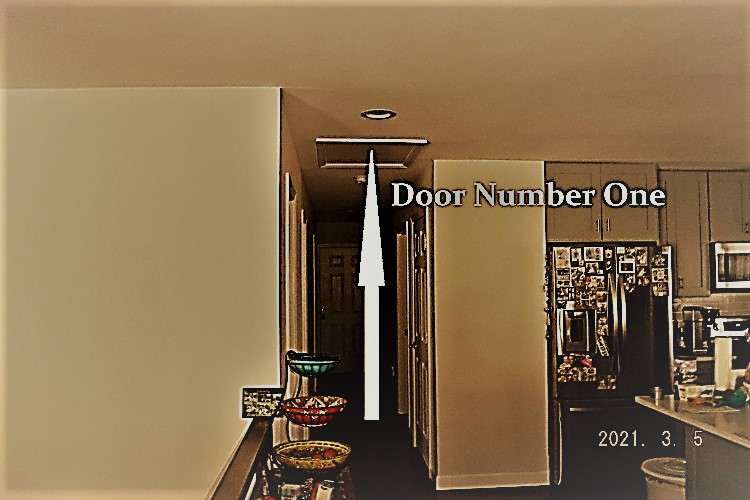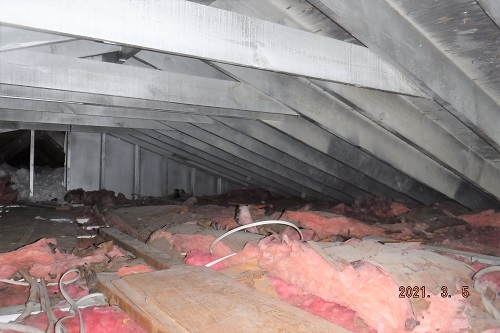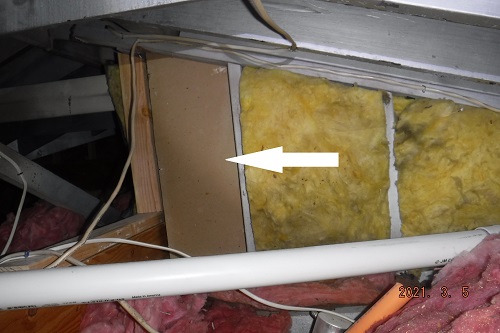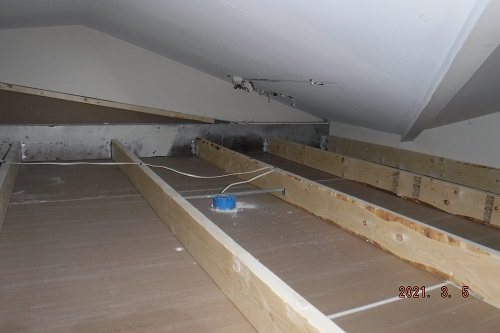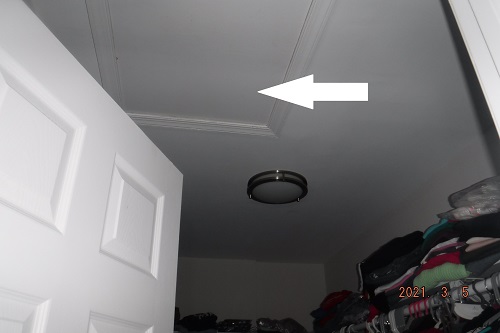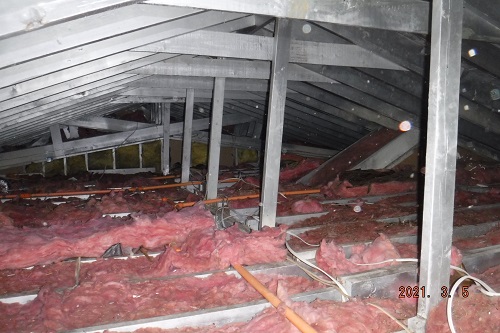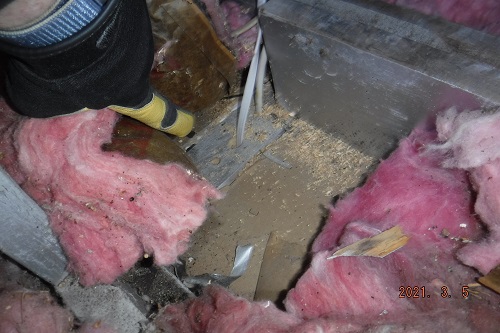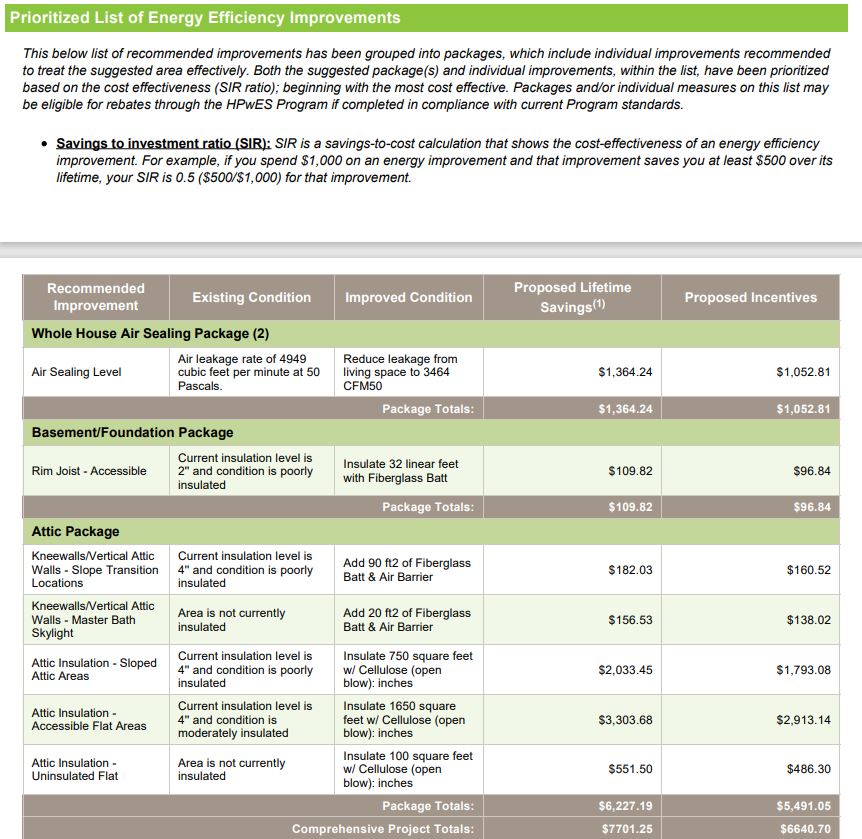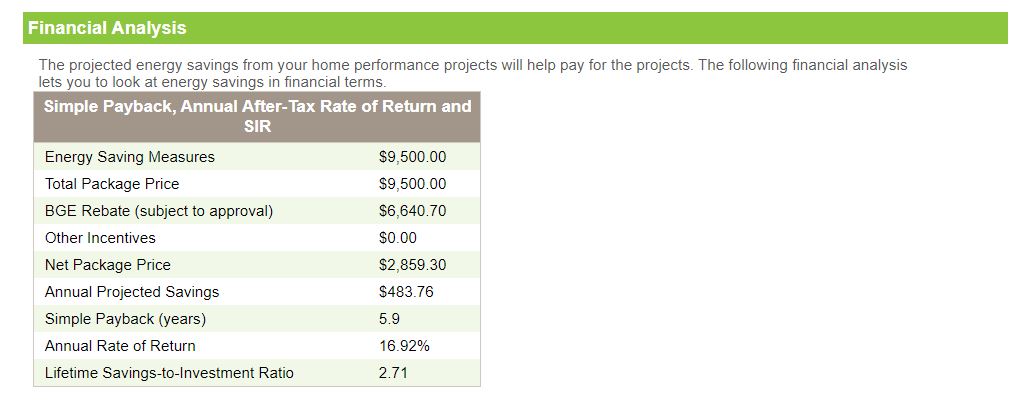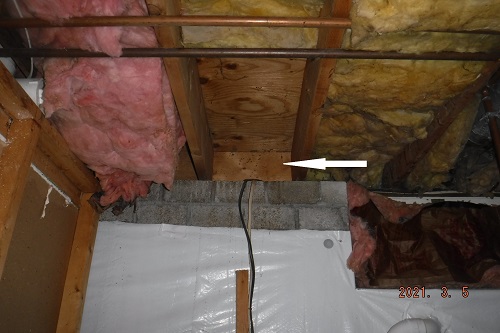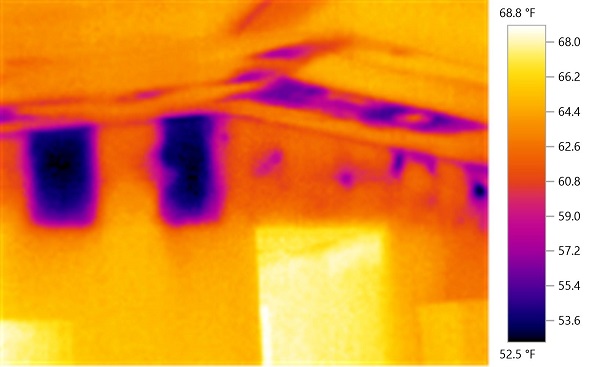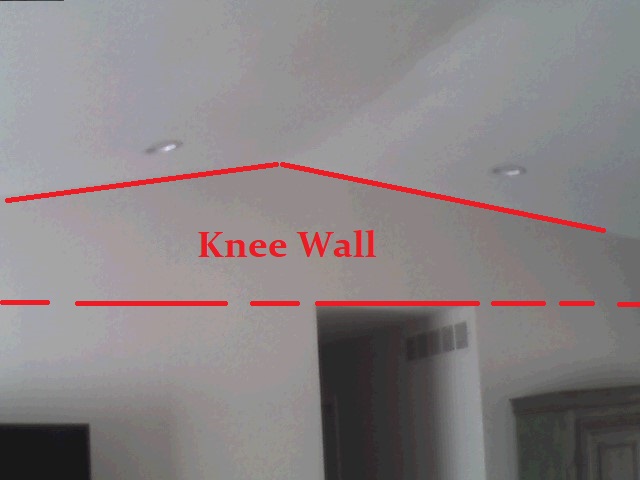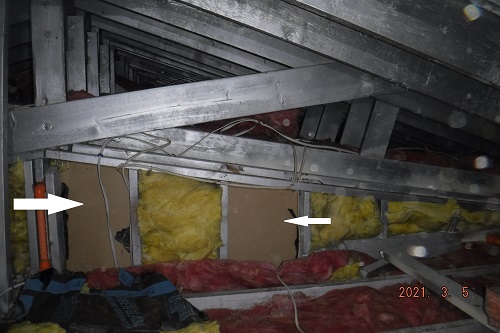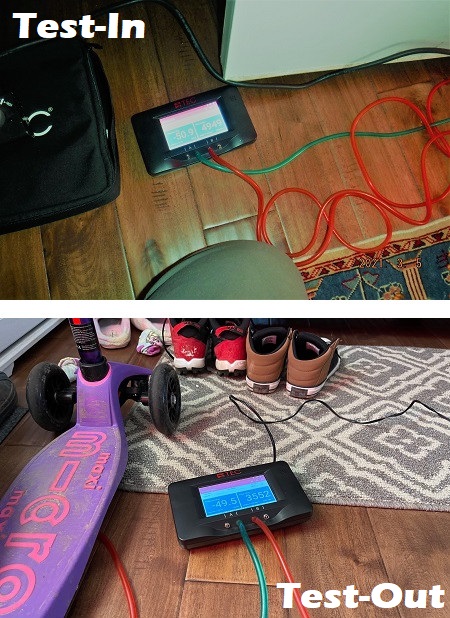Residential Comfort & Energy EfficiencyTuesday, March 09 2021
There are literally thousands of homeowners in Maryland that are a lot closer to having a more comfortable home than they ever could have imagined. Let me explain... In March 2021 I did a BGE energy audit in Howard County for a really nice family that just moved back to Maryland from a warmer part of the country around the end of summer 2020. They reported to me that their first winter here was brutal. Cold spots at every turn, drafts in areas they enjoyed to spend time and the basement has been all but abandoned, despite having a nice playroom and a video game console with surround sound. But on the coldest days it was just too much. Two Reasons this Audit Makes a Great Case StudyFirst, the family was pretty much in the dark all winter about what they could do about their issues. They love the home and the location, but something seemed wrong and they really did not know where to turn for solutions. The HVAC was running continuously and never caught up. Here is the other thing too - they just came off of having a home inspection done when they bought the property. What I have observed from time to time is that a home inspection gives homebuyers a false sense of security, particularly when it comes to insulation. The inspection is more in line with the old way of thinking about insulation... I see pink stuff in the attic - all is good. The box gets checked and you, the end user, is puzzled by the drafts and looking at windows and doors for answers to why it is so cold. But, as you will see, the inspector missed a few key things and did not give any guidance at the time that would assist the family in finding a swift solution. So, instead, they spent the winter draped in blankets studying their window and door seals wondering if there was anything that could be done. We cannot blame the inspector though. Some of the key insulation concepts get lost on the best home inspectors. It can get a little complicated. The second thing that was fantastic about this scenario is that the BGE Home Performance with ENERGY STAR® program helped the family uncover their underlying issues and the incentives, available to all BGE and Pepco customers, paid for 70% of the cost in this case. "The BGE Home Performance with Energy Star® Program will pay for 70% of the cost."
The part about all of this that gets my wheels spinning is how many other people are out there, enduring miserable winters, or hot summers for that matter, that could also benefit from this program in the exact same way. This case study clearly demonstrates why an energy audit is such a critical assessment for a home to undergo. The same problems are happening in households everywhere in Maryland. Energy Audit - A Critical Home AssessmentAn energy audit can illuminate comfort problems that would otherwise stay hidden in plain sight and this case study is a classic. The Symptoms for this BGE Customer Case Study -HVAC running all of the time I want to stop here and place a little emphasis on this list. I believe that this is where the disconnect exists for a customer that has these issues in their home and never gets an energy audit done. There is an expression that my dad would use - "if I had a nickel for every..." If you add up all of my energy audits over the years, I would say that I would have fully completed roughly 1300 of them. And, if I had a nickel for every customer that blamed their windows and doors - I would likely have 40 bucks (that is about 62% of the people if you don't wanna do the math). The underlying message here is that if you have not gotten an energy audit because you think it is your windows and doors, then you might be surprised. Most people that have the audit done always seem quite enlightened by what is actually causing their problems. The Case Study - Figuring Out the Root CauseAn energy audit is a process of gathering data points around your home. The volume, square footage, foundation layout and type are all important to help you find the best solutions for making things better. Sometimes, the first hour of an audit does not prove to be fruitful in terms of "opportunities" for improvements, or retrofits. A well trained energy auditor never wants the cost of the project to outweigh the benefits. An auditor is on the hunt for the low hanging fruit. As an energy auditor, you can have some fun with this. It can be much like the game show Let's Make a Deal. Every door you open to an attic or crawl space presents a unique set of circumstances that will either prove to be a great chance to move the comfort needle for the customer or it could be a dead end. Now, this can also be kind of a slippery slope. Great opportunities also come with a cost. Meaning, if your home is stubbornly uncomfortable and the places that require insulation are under insulated and accessible that is fantastic because you can fix it! But, it also means that you have to spend money to do so. But, as mentioned, there are incredible incentives through BGE and Pepco available to help manage the cost. Time to Investigate the AtticThis particular home has two sections of accessible attic space. One access point is in the hallway. I took a trip up through door number one to inspect the attic space.
The first sign upon poking my head up is that the attic floor is insufficiently insulated. One thing I have learned through the years is that those with some of the biggest issues have rolled batt insulation in the attic as this home did. Read what John Krigger and Chris Dorsi say about fiberglass batt insulation in the book Residential Energy: Cost Saving and Comfort for Existing Buildings "All of the common facings attached to fiberglass batts are air barriers and most are vapor barriers. However, their effectiveness as an air barrier depends on nearly flawless installation." Fiberglass batt insulation is almost always not installed to perfection. Now, I can't be sure about what I am about to say, but this is where I believe most energy auditors stop. They take a quick peak at the attic and draw every conclusion for that specific attic area without proper investigation. I take pride in going the extra few steps and I find that is usually proves to be beneficial - for my customers. The rule is if I don't really want to go over to that spot then chances are not too many people do and therefore there could be a problem there that nobody has ever seen.
When I got in the attic and made a 180 degree turn, I saw what appeared to be a knee wall that was missing insulation. The area was in a tough to reach part of the attic. I decided to go around the corner to see what was going on because it was not quite making sense to me. As with anything that you do on the regular, patterns emerge and a more comprehensive understanding of what you are doing comes over time - aka: experience. Adding to my sense of curiosity was the fact that during my initial tour of the home, the customer had pointed out to me that some remodeling was done in the vicinity below before they bought the home. A good home energy auditor has to be a like a sponge, absorbing bits of information throughout the time at the home so it can all be pulled together to produce sound solutions.
Then, once I was able to poke around the corner this is what I found. A ten by ten area of un-insulated attic space hiding behind that wall. This is important for two reasons. Reason One - it speaks to the issues that they were experiencing on cold days. Having insulation at the attic floor is the most important place to build the insulation boundary because the pressure is greatest. Hot air rises in a building and it wants to fly right out of the top and will if you let it. Cracks and crevices are certainly big time issues for this, but because insulation slows the transfer of heat, the thin drywall alone is no match for the heat to escape at very high rates. Missing insulation is a big time issue. In an earlier article I wrote about how I examined the impact of an un-insulated three by six foot area in an approximate thousand square foot attic (2% if the area) equated to a 25% reduction in the overall R-value of the insulation in that particular attic. Reason Two - it produces a larger incentive through the BGE Home Performance program. Some of the rebate calculations are based on how much insulation an attic currently needs and when there is nothing, it pushes the incentive up. Missing the un-insulated area and modeling the home as if it did have insulation in that area would be cheating the customer. My final mission while in this section of the attic was to determine if I could make passage to the other side of the home and I was able to confirm that I could not and had to use the second attic entrance.
Second entrance to the attic was located in the master bedroom closet.
More of the same in the second attic area.
The verdict is in! This attic needs to be air sealed and insulated. Time to run the numbers! How Does this Program Pay for 70% of the Cost?In order to help you understand how this program works, I will share the exact numbers from this project and how it worked out so favorably for this customer and you can hopefully gleen information to compare to your own situation and see if you can benefit like the family in this scenario. But, if you don't have all or any of these characteristics in your home, that does not mean you will not qualify for rebates or that an energy audit won't uncover some totally different issue for you that will find a way to make it well worth your while. The NumbersPrioritized List of Energy Efficient Improvements
Total Cost of Improvements: $9500.00 Total Ratio: 70% of the total cost Financial Analysis
|
|
Air Flow at Test-In = 4949 Cubic Feet Per Minute After Air Sealing Air Flow at Test-Out = 3552 Cubic Feet Per Minute 28% Reduction |
Take a look at a short example of how we measure air sealing results with a blower door.
Customer Satisfaction - Measured Results
It is one thing to hit the mark on the numbers and achieve the goals when it comes to measuring the work that was performed.
Another part of a successful Home Performance with ENERGY STAR project is the customer's overall experience. It certainly would be fantastic to have a more comfortable home with lower bills, but having a pleasant experience along the way should also play into things.
Based on a recent review by the customer on Google, it seems like we hit the mark on this one too! Making this a successful project all the way around!
"Had a great experience with Eric and his team. Eric conducted our home energy audit taking time to point out and discuss the good and bad, answering all my questions. He also took care of the whole rebate process with the local utility. All phases of project completed in about 3 weeks. Easy and painless. Definitely recommend Eric and the Hometrust team!"
Need Advice on How to Do Something Like This?
If you are interested in making your home more comfortable and more efficient, give me a call. We can discuss your situation and likely getting a BGE or Pepco Energy Audit is the way to go.
Incentives through the program can be quite advantageous, particularly for those that know that they have to get this problem resolved once and for all.
Furthermore, an energy audit can uncover other factors that can contribute to your specific issue as each home is different - even the same model across the street.
Give me a call! I'd love to help you out!
Written by Eric Gans
I have over 1000 energy audits under my belt in Maryland. I like to take my personal experiences with each of my audit customers and try to get the things that concern them out into the world so others can make good home improvement decisions - in the right order - according to their needs.
Most homes nowadays have air ducts that condition the inside of our living spaces. Ducts are largely responsible for keeping us warm in winter and cool in summer.
And, yet despite their importance, they are often overlooked.
Aside from the obvious, like making sure ducts are connected, there are other nuances that must be understood to prevent other potential issues. For example, leaky ducts in summer in the wrong location might lead to condensation resulting in water damage to ceilings or wood.
This article will examine summer condensation issues related to ducts that run outside of the "envelope". This would include ducts that run through a garage (the focus of this post), crawl space, attic or cantilever also known as an overhang.
Watch the Four Part Process First - Then Learn How it Came About
Part 1 -The blank canvas. A fully removed plaster ceiling including the removal of nails and screws. The area beneath the ducts has been swept and protective platic has been installed to keep the area clean and neat for the customer once the project is completed.
Part 2 -Application of the spray foam on the different areas of the HVAC supply plenum. During this portion of the video, the foam bonds to the duct and seals and insulates rapidly.
Part 3 -Removal of excess insulation after it has fully cured. This is done in preparation for the drywall ceiling installation later in the week.
Part 4 -A look at the completed portion of the duct sealing and insulation project to get a feel for the final product.
Initially - I Was a Little Worried About this Project
According to my eventual customer, the garage ceiling insulation project had already been contracted to be done and when the chosen company showed up to do the work, they promptly turned around and said it was too much for them to handle. That, in turn, prompted the customer to call me.
But, when I went out to take a look at the garage and all that was involved, it did not appear to be too much as far as I was concerned and I quickly got to assessing the situation for the best way to get it done!
Insulated Ducts Are Not Sealed Ducts
If you so dare to pop your head in the attic and you see that your ducts are insulated you cannot simply assume that everything is in good shape. Ducts are metal casings that have seams and connection points. Not all duct insulation is designed to seal the small air leakage around seams.
Older ducts in older homes like the ones in the garage example below were not made as precisely as they are today. Some systems have slots and cracks from shifts that occur normally in a home.
Additionally, houses go through changes and therefore the paths that the conditioned air takes have to be altered.
One example can be seen commonly when the central furnace/ air conditioner is replaced with a larger unit at the same time an addition is being put on a house. The larger system is now being called upon to provide heating and cooling to the new living space.
During this process, the existing ducts are "tapped" so that new ducts can be run to the addition.
It is during these re-configurations where some of the largest gaps and cracks can be detected in the ducts. Of course, the ones you can get to should and can be sealed, but the harder to reach leaks in the areas outside of the "envelope" are the ones that can be trouble.
Garage Ceiling Example
In this example, the home was built in 1958. For a home built in 1958, it was likely cutting edge. Living space over a two car garage with a design that included ducts running through the ceiling to service the space above. In theory, it was practical, efficient and ahead of its time.
But, as each and every Maryland summer would introduce new hot, humid air into the garage it would find its way more and more into the the space between the garage ceiling and the floor to the living space above and as the central air conditioner was improved and likely the sized increased - the ducts began to form condensation.
Drip...drip...drip...and eventually the water actually blew right through the insulation that was installed when the home was built (can be seen in photo below). Soon after, the plaster ceiling began to deteriorate and it had to be partially torn down.
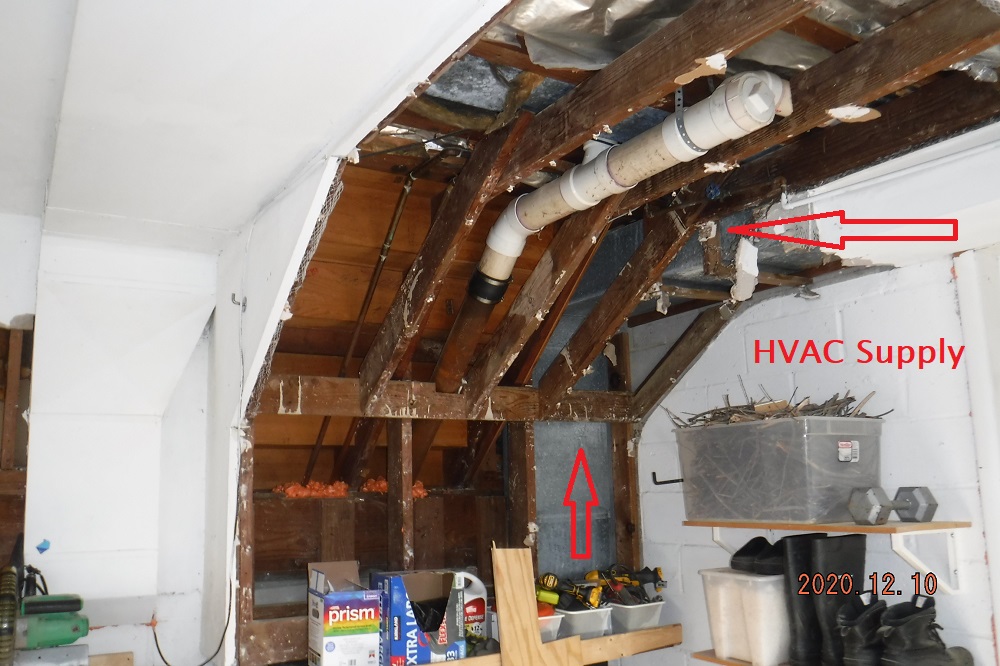
Photo taken during initial inspection. Partial demo had already begun.
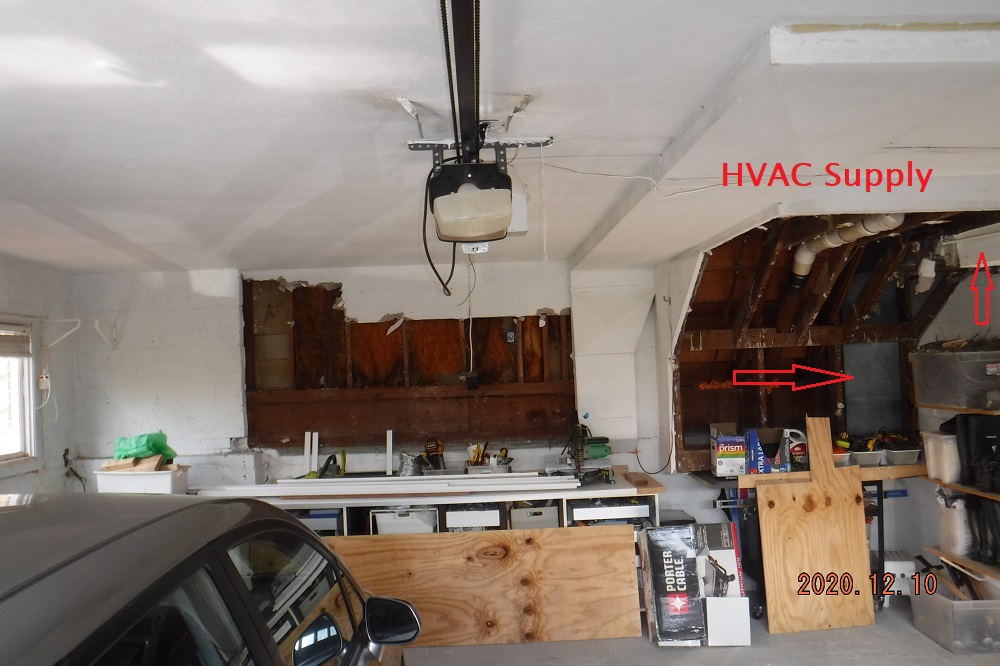
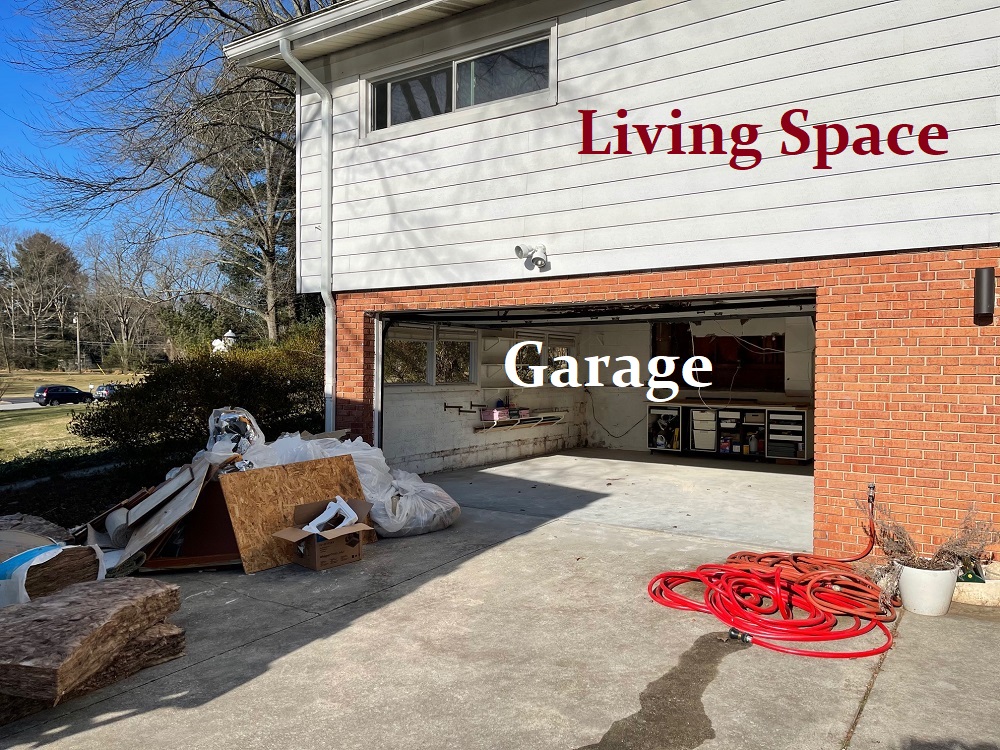
A little more perspective of the area to be treated due to duct condensation issues during summer months.

Making the Most of the Situation
The driving force for this homeowner to take on this project was the duct condensation and the long term issues that can come about if they go untreated. But, another reason for taking this on was due to the cold bedrooms above during the heating season.
It was clear that the old insulation methods and the unsealed and un-insulated ducts running through the outside garage ceiling were contributing to the comfort issues.
So, the plan included insulating the entire garage ceiling area as well. The plaster ceiling was removed on day one, insulation was applied and the area was cleared of all trash and debris.
Day 2
On day two the focus was on the main HVAC supply plenum (duct). Final demo on the ceiling area that encapsulated the duct took place and preparations were made to seal the duct with two part spray foam.
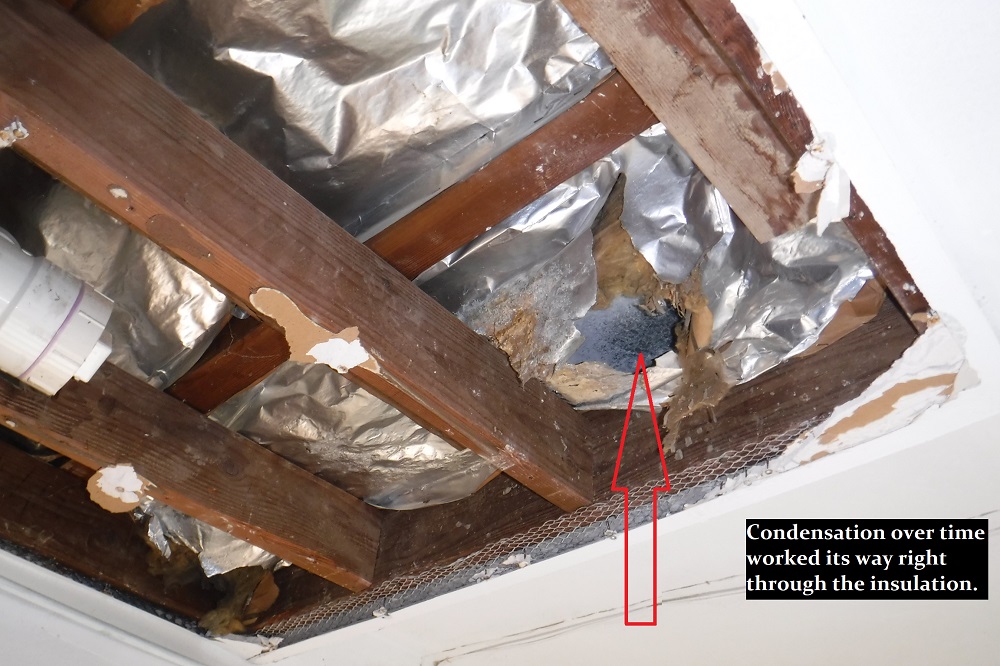
Everything in the photo above is vintage 1958. Sixty three years of water dripping down and creating a major blowout of the insulation, resulting in a damaged garage ceiling.
Special attention was going to be given to this area. Since it was very close to where the HVAC air handler was located the pressure is greatest, therefore the more significant duct sweating that was taking place.
The Solution - Sealing and Insulating in One Shot
Two part spray foam is an effective treatment for a situation such as this one. The removal of the ducts and the disruption and cost would outweigh the additional cost for the more expensive insulation material. Getting behind to seal the tight spaces without having to remove flooring or support bracing is a great advantage of using spray foam.
You can see in the video the amazing capabilities of the liquid spray finding its way behind the ducts and moving to seal up the spaces that we know exist, but would have a tough time accessing otherwise.
Need Advice on How to Do Something Like This?
If you are interested in solving your duct condensation issue, give me a call. We can discuss your situation and likely getting a BGE or Pepco Energy Audit is the way to go.
Incentives through the program can be quite advantageous, particualarly for those that know that they have to get this problem resolved once and for all.
Furthermore, an energy audit can uncover other factors that can contribute to condensation on ducts and the audit may uncover other solutions that render the need to insulate the ducts useless - while still solving the main issue.
Give me a call! I'd love to help you out!
Written by Eric Gans
I have over 2000 energy audits under my belt in Maryland. I like to take my personal experiences with each of my audit customers and try to get the things that concern them out into the world so others can make good home improvement decisions - in the right order - according to their needs.








